BUICK SKYLARK 1993 Manual PDF
Manufacturer: BUICK, Model Year: 1993, Model line: SKYLARK, Model: BUICK SKYLARK 1993Pages: 306, PDF Size: 15.84 MB
Page 71 of 306
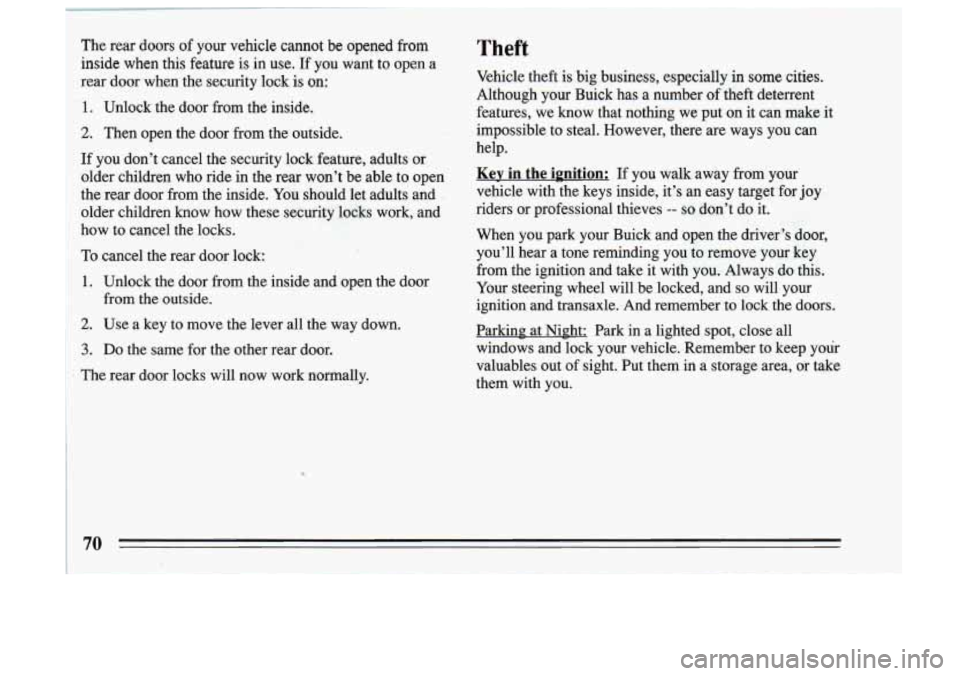
The rear doors of your vehicle cannot be opened from
inside when this feature is in use. If you want to open a
rear door when. the security lock is on:
1. Unlock the door from the inside..
2. Then open the door from the outside.
If you don’t cancel the security lock feature, adults or
older children who ride in the rear won’t be able to open
the rear door from the inside. You should let adults and
older children know how these security locks work, and
how to cancel the locks.
To cancel the rear door lock:
1. Unlock the door from the inside and open the door
2. Use a key to move the lever all the way down.
from the outside.
3. Do the
same for the other rear door.
. The rear door locks will now work norinally.
Theft
Vehicle theft is big business, especially in some cities.
Although your Buick has a number
of theft deterrent
features, we know that nothing we put on it can make it
impossible to steal. However, there are ways you can
help.
Kev in the ipnition: If you walk away from your
vehicle with the keys inside, it’s an easy target for
joy
riders or professional thieves -- so don’t do it. . .) ..
When you park your Buick and open the driver’s’a*oor,
you’ll hear a tone reminding you to remove your key
from the ignition and take it with you. Always do this.
Your steering wheel will be locked, and
so will your
ignition and transaxle. And remember to lock the doors.
: .+.,-:.,: <::: ., .,<. , p,
Parking at Night: Park in a lighted spot, close all
windows and lock your vehicle. Remember to keep your
valuables out of sight. Put them in a storage area,
or take
them with you.
Page 72 of 306
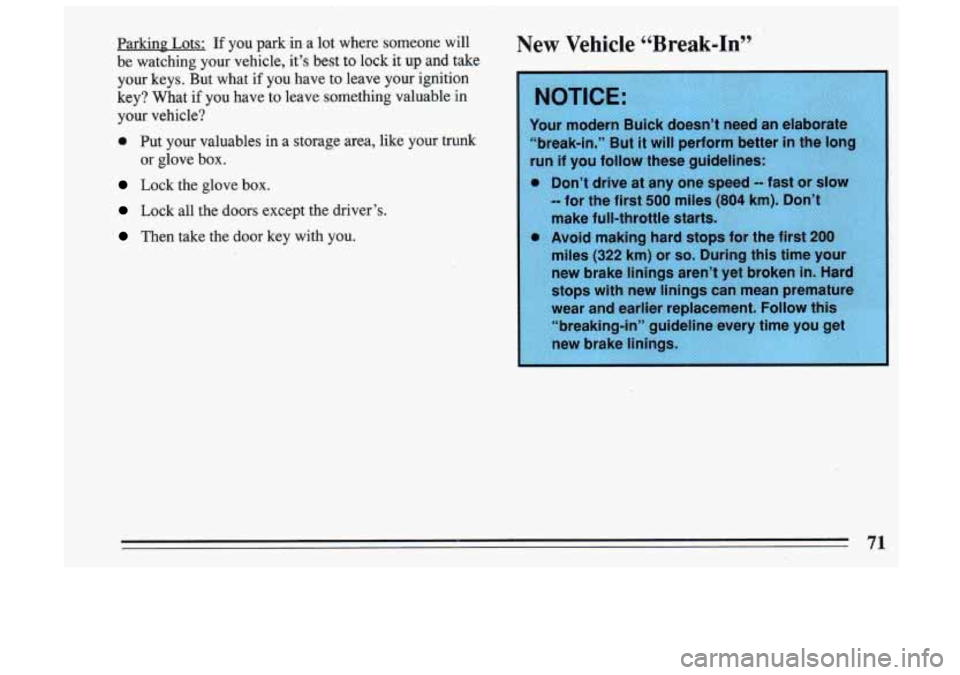
ParkinP Lots: If you parkin a lot where someone will
be watching your vehicle, it’s best to lock it up and take
your keys. But what
if you have to leave your ignition
key? What
if you have to leave something valuable in
your vehicle?
0 Put your valuables in a storage area, like your trunk
or glove box.
Lock the glove box.
Lock all the doors except the driver’s.
Then take the door key with you.
New Vehicle 6CBreak-In”
Page 73 of 306
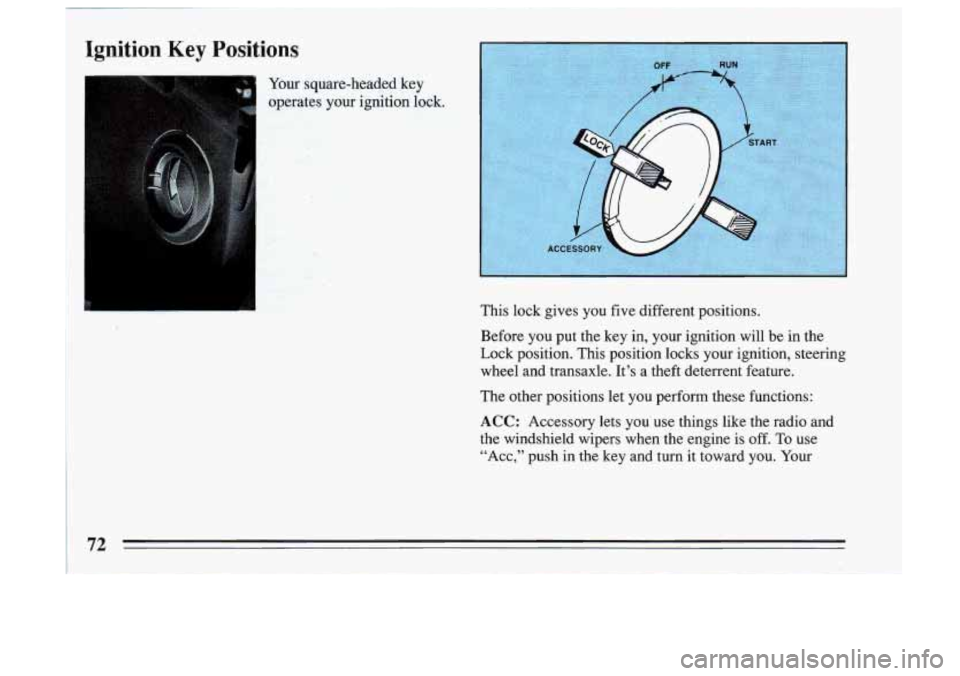
Ignition Key Positions
Your square-headed key
opgs.@gs ,. .r , your ignition lock. ..
This lock gives you five different positions.
Before you put the key in, your ignition will be in the
Lock position. This position locks your ignition, steering
wheel and transaxle. It’s a theft deterrent feature.
The other positions let you perform these functions:
ACC: Accessory lets you’use things like the radio and
the windshield wipers when the engine is
off. To use
“Acc,” push in the key and turn
it toward you. Your
72
Page 74 of 306
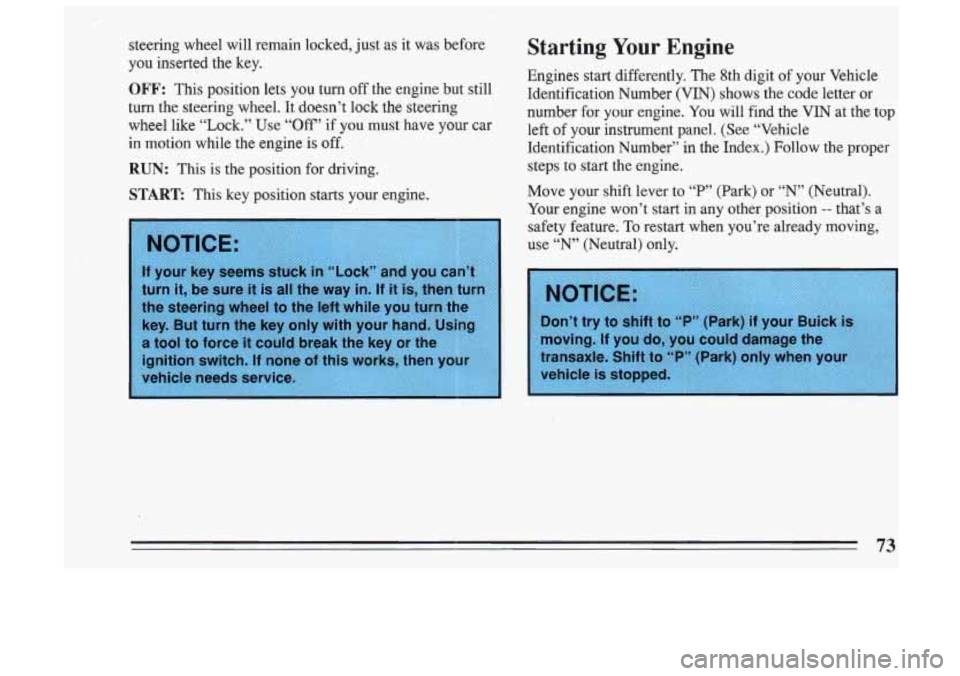
steering wheel will remain locked, just as it was before
you inserted the key.
OFF: This position lets you turn off the engine but still
turn the steering wheel. It doesn’t lock the steering
wheel like “Lock.” Use
“Off’” if you must .have your car
in motion while the engine is
off.
RUN: This is the position for driving.
START This key position starts your engine.
Starting .Your Engine
Engines start differently. The 8th digit of your Vehicle
Identification Number (VIN)
shows the code letter or
number for your engine. You will- find the VIN at the
top
left of your instrument panel. (See “Vehicle
Identification Number” in the Index.) Follow the proper
steps to start the engine.
Move your shift lever to
“P” (Park) or “N” (Neutral).
Your engine won’t start in any other position
-- that’s a
safety feature;
To restart when you’re already moving,
use
“N’ (Neutral) only.
73
Page 75 of 306
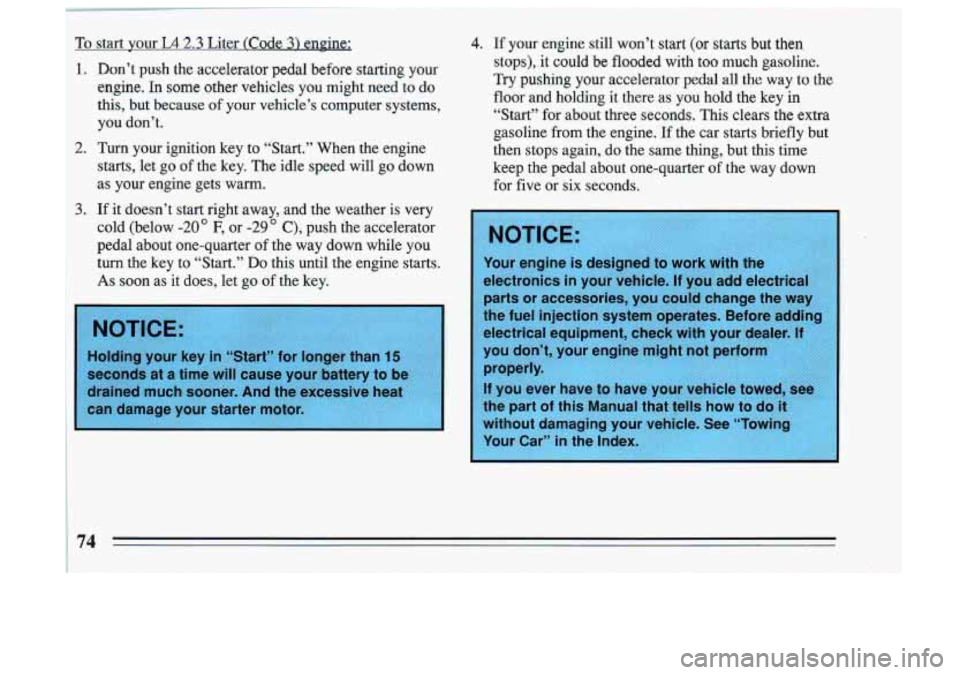
1 To start your L4 2.3 Lites (Code 3) engine:
I
Don’t push the accelerator pedal before starting your
engine. In some other vehicles you might need to do
this, but because of your vehicle’s computer systems,
you don’t.
Turn your ignition key to “Start.” When the engine
starts, let go of the key. The idle speed will go down
as your engine gets warm.
If it doesn’t start right away, and the weather is very
cold (below
-20’ .F, or -29’ C), push the accelerator
pedal about one-quarter of the way down while you
turn the key to
“Start.” Do this until the engine starts.
As soon as it does, let go of’the key.
4. If your engine still won’t start (or starts but then
stops), it could
be flooded with too much gasoline.
Try pushing your accelerator pedal all the way to the
floor and holding it there as you hold the key in
“Start” for about three seconds. This clears the extra
gasoline from the engine.
If the car starts briefly but
then stops again, do the same thing, but this time
keep the pedal about one-quarter of the way down
for five or six seconds.
electronics in your vehicle. If you add electrical
electrical equipment, check
you don’t, your engine rnigh
the part
of this Manual that tells how to do it
without damaging your vehicle. See “Towin
Your Car” in the Index.
74
Page 76 of 306
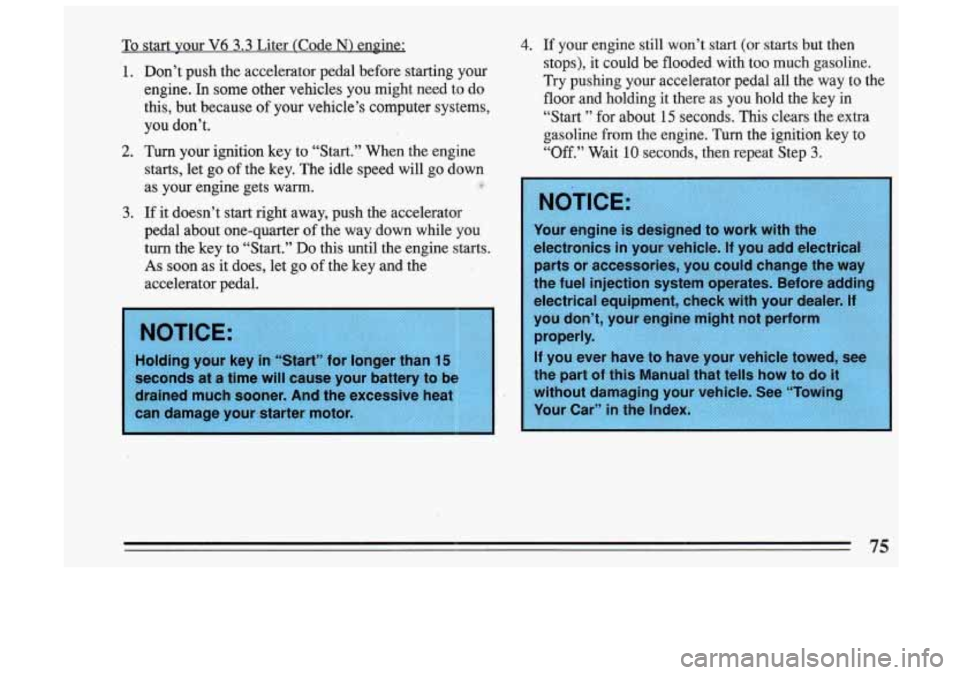
To start your V6 3.3 Liter (Code N) engine:
1.
2.
3.
Don’t push the accelerator pedal before starting your
engine. In some other vehicles you might need to do
this, but because
of your vehicle’s computer systems,
you don’t.
Turn your ignition key to “Start.” When the engine
starts, let go
of the key. The idle speed will go down
as your engine gets warm.
.4
If it doesn’t start right away, push the accelerator
pedal about one-quarter of the way down while you
turn the key to “Start.”
Do this until the engine starts.
As soon as it does, let go of the key and the
accelerator pedal.
4. If your engine still won’t start (or starts but then
stops), it could be flooded
with too much gasoline.
Try
pushing your accelerator pedal all the way to the
floor and holding
it there as you hold the key in
“Start
” for about 15 seconds. This clears the extra
gasoline
from the engine. Turn the ignition key to
“Off.” Wait 10 seconds, then repeat Step 3.
seconds at a time will cause your battery to be
drained much sooner. And the excessive heat
can damage your starter motor.
75
Page 77 of 306
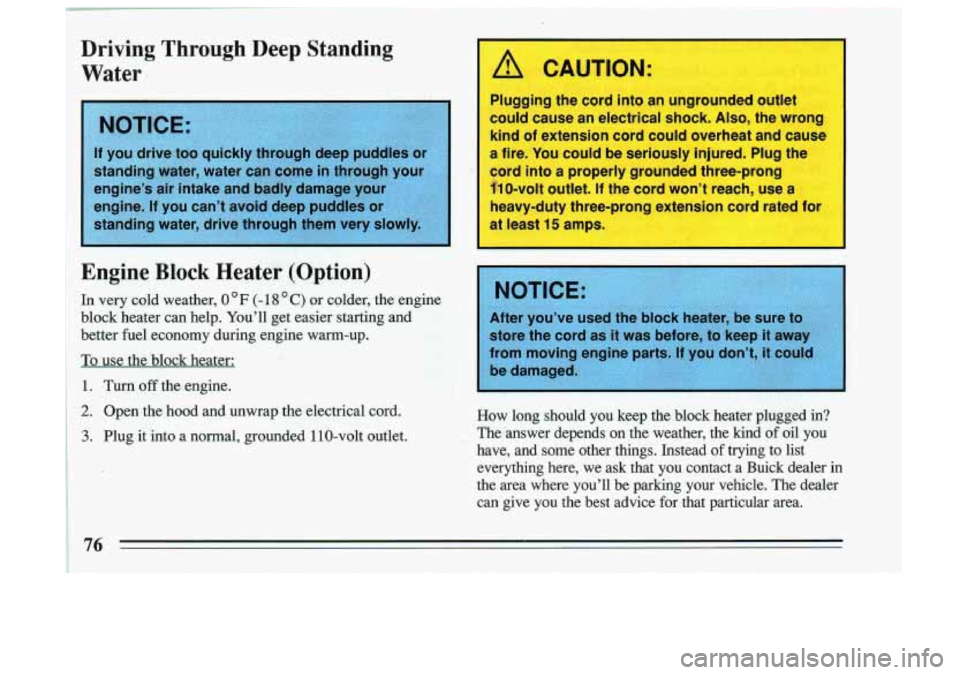
Driving Through Deep Standing
Water
If you drive too quickly through deep puddles 01
standing water, water can come in through
engine’s air intake and badly damage your
engine.
If you can’t avoid deep puddles or
standing water, drive through them very slowly.
Engine Block Heater (Option)
In very cold weather, O°F (-18 “C) or colder, the engine
block heater can help. You’ll get easier starting and
better fuel economy during engine warm-up.
To use the block heater:
1. Turn off the engine.
2. Open the hood and unwrap the electrical cord.
3. Plug it into a normal, grounded 110-volt outlet.
1 A
CAUTION:
Plugging the cord into an ungrounded outlet
could cause an electrical shock.
Also, the wrong
kind of extension cord could overheat and cause
a fire. You could be seriously injured. Plug the
cord into a properly grounded three-prong
110-volt outlet.
If the cord won’t reach, use a
heavy-duty three-prong extension cord rated for
at least
15 amps.
I
How long should you keep the block heater plugged in?
The answer depends on the weather, the kind of oil you
have, and some other things. Instead
of trying to list
everything here, we ask that you contact a Buick dealer in
the area where you’ll be parking
your vehicle. The dealer
can give you the best advice for that particular area.
Page 78 of 306
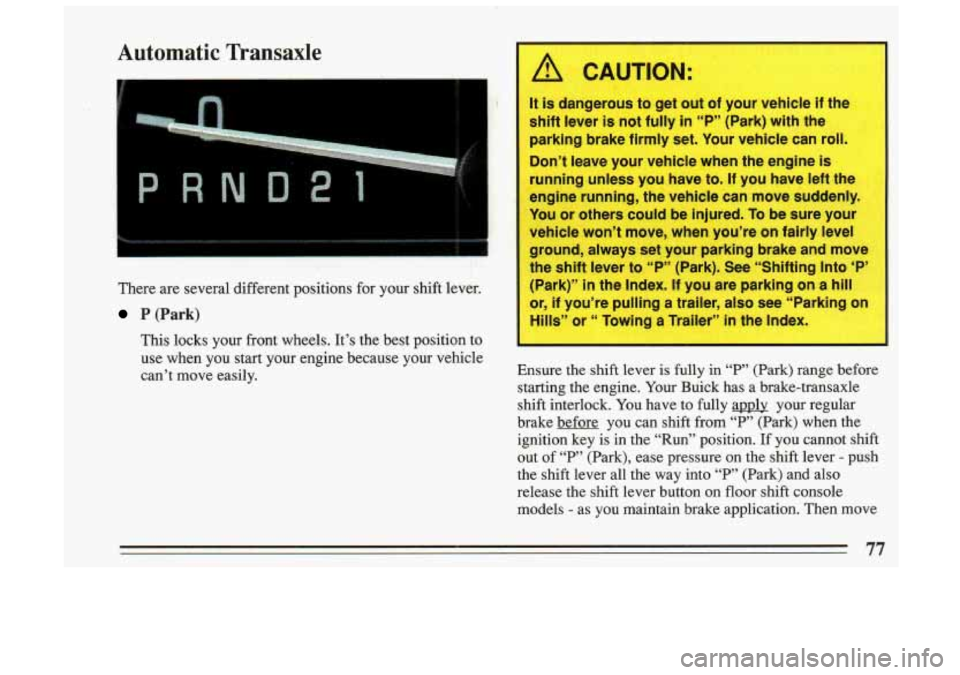
Automatic Transaxle
There are several different positions for your shift lever.
P.(Park)
This locks your front wheels. It’s the best position to
use when you start your engine because your vehicle
can’t move easily.
A CAUTION:
It is dangerous to get out of your vehicle if the
shift lever
is not fully in “P” (Park) with the
parking brake firmly set. Your vehicle can
roll.
Don’t leave your vehicle when the engine is
running unless you have to. If you have left the
engine running, the vehicle can move suddenly.
You or others could be injured.
To be sure your
ehicle won’t move, when you’re on fairly level
ound, always set your parking brake and move
e shift lever to
“P” (Park). See “Shifting Into ‘P’
ark)”
in the Index. If you are parking on a hill
, if you’re pulling a trailer, also see “Parking on
11s” or “ Towing a Trailer” in the Index.
Ensure the shift lever is fully in “P” (Park) range before
starting the engine. Your Buick has a brake-transaxle
shift interlock. You have to fully apply your regular
brake before you can shift from “P” (Park) when the
ignition key is in the “Run” position.
If you cannot shift
out of
“P” (Park), ease pressure on the shift lever - push
the shift lever all the way into
“P,’ (Park) and also
release the shift lever button on floor shift console
models
- as you maintain brake application. Then move
77
Page 79 of 306
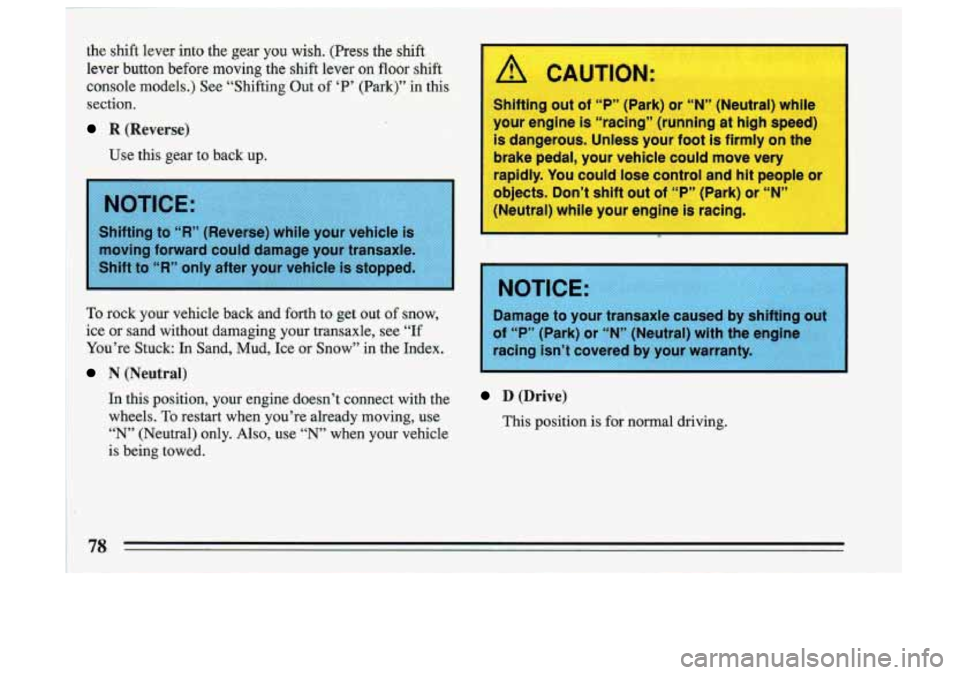
1 the shift lever into the gear you wish. (Press the shift
lever
button before moving the shift lever on floor shift
3: console models.) See “SI
section,
R (Reverse)
Use this gear to back ifting’ Out
of ‘I?’ (Park)” in this
To rock your vehicle back and forth
to get out of snow,
ice
or sand without damaging your transaxle, see “If
You’re Stuck: In Sand, Mud, Ice or, Snow” in the Index.
N (Neutral)
In this position, your engine doesn’t connect with the
wheels. To restart when you’re already moving,
use
“N” (Neutral) only. Also, use “N’ when your vehicle
is being towed.
I
A CAUTION:
hifting out of ‘‘P” (Park) or “N” (Neutral) while
our engine is “racing” (running at high speed)
s dangerous. Unless your foot is firmly on the
rake pedal, your vehicle could move very
apidly. You could lose control and
hit people or
bjects. Don’t shift out of
“P” (Park) or “N”
[Neutral) while your engine is racing.
Damage to your transaxle caused by shifting out
I
of “P” (Park) or “N” (Neutral) with the engine
racing isn’t covered by your warranty.
I
D (Drive)
This position is for normal driving.
Page 80 of 306
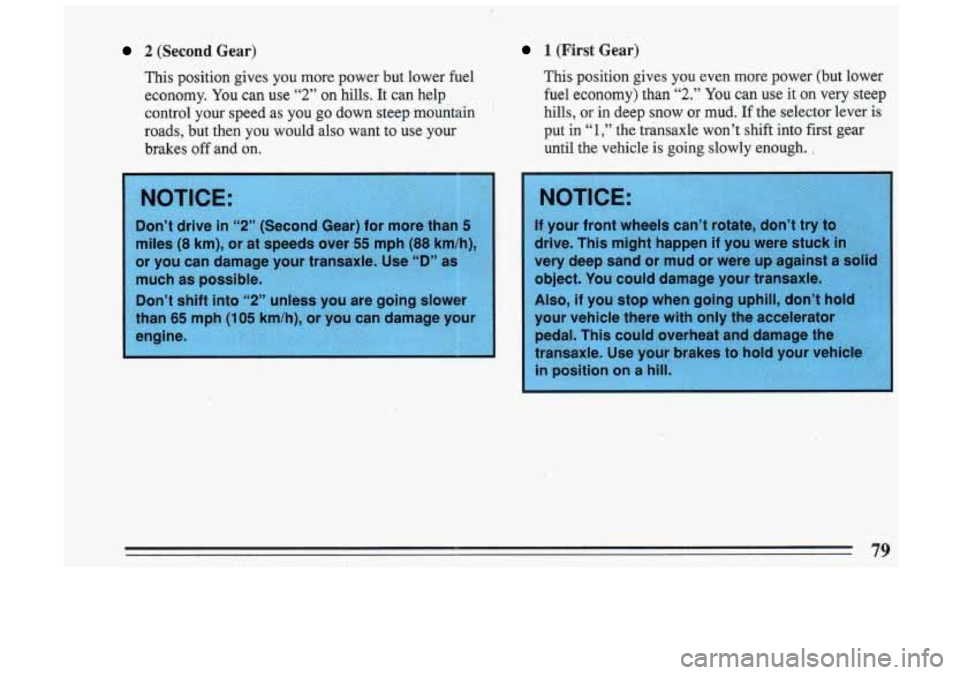
2 (Second Gear)
This position gives you more power but lower fuel
economy. You can use
“2” on hills. It can help
control your speed as you go down steep mountain
’
roads, but then you would also want to use your
brakes
off and on.
1 (First Gear)
This position gives you even more power (but lower
fuel economy) than
“2.” You can use it on very steep
hills, or in deep snow or mud.
If the selector, lever is
put in
“1,” the transaxle won’t shift into first gear
until the vehicle
is going slowly enough. ,
Don’t drive in “2” (Second Gear) for more than 5
miles (8 km), or at speeds over 55 mph (88 km/h),
or you can damag ansaxl
much as possible.
Don’t shift into “2” unless you are going
slower
than 65 mph (105 km/h), or you can damage your
engine.
79